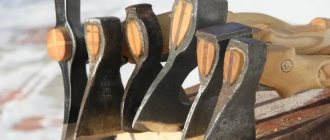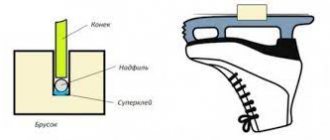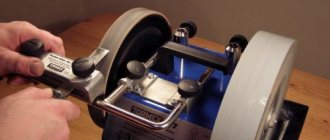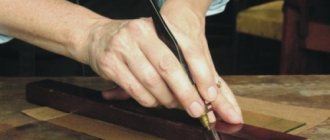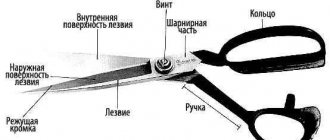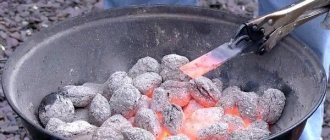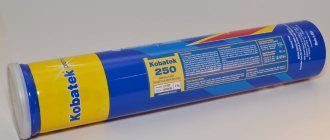Have your skates begun to glide poorly and become unresponsive when turning? So it's time to think about sharpening! Taking care of your blades will not only restore your former speed on the ice, but will also allow you to customize your skates to suit you. But it’s better to take them to a workshop, because sharpening a cutting edge is far from easy...
Skates, like any other sports equipment, require regular care. The main element is the cutting edge, which digs into the ice during skating under the weight of the weight, becoming dull and deformed over time.
Damage or loss of sharpness of the skate affects:
- sliding speed;
- acceleration rate;
- maneuverability on ice.
Therefore, when you notice that your skates have begun to behave differently, pay attention to sharpening. If the edge is dull, it needs to be corrected urgently. Otherwise, you risk either completely ruining your skates or getting injured. Plus, it’s always more enjoyable to skate on good skates, and during active recreation, it’s the sensations and emotions that matter.
If your skates look like this, then it's high time you thought about sharpening them!
Blade Profiling
The blade profile is the outline of the blade from toe to heel. When profiling the blade, you need to determine the central upper point, it is on it that the maximum load will be placed when skating, and also determine the contact spot - this is the area of the blade along which the sliding itself occurs.
A lot depends on how the skates are sharpened, so professional athletes change the geometry of the blade to suit their needs. Actually, it depends on the profile of the blade how the skates will hold the athlete during turns and braking or at the speed of gliding.
When profiling the blade, it is necessary to take into account the weight of the athlete and his skating style, because it is the profile that will be responsible for maneuverability on the ice. The greater the weight of the athlete, the larger the contact spot should be.
There are three main blade profiles and they are used in hockey, speed skating and figure skating.
Non-professional athletes use standard sharpening parameters, the area of which is 1 cm, and the radius of the edge is 14 feet. It is with these parameters that all skates are sold in sports stores.
Interesting:
If we take hockey into account, then the profile of the blade of the attacker and defender will be different, since the players have different tasks during the game.
Profile "Site"
This profile is used mainly only in Russia, the length of the platform of this profile is 50 mm, and the radius remains standard at 14 feet. At the same time, to increase the contact of the blade with the ice, the top point is cut off so that an even line with a length of 4o to 6o mm is formed.
Classic profile
The radius longitudinal profile is measured by the radius in feet. For example: 14″ designation means the radius of the profile template is 14 feet. Used for profiling the blades of hockey skates: children's, beginner hockey players and amateurs. Sharpening is done on machines according to factory patterns with a sharpening radius from 7″ to 30″.
The most popular single profile patterns for children's skates:
- for small players with good skating skills - 11″
- for beginner young players - 15″
- for beginner young players with heavy weight – 17″
Combined profile
The blade of a hockey skate can be divided into three working zones: toe, middle, heel. Each zone is responsible for performing its own maneuver (turn, turn, slide). The essence of the method. Each part of the blade has its own spot of contact with the ice. After profiling, a blade with a complex configuration is obtained. Sharpening is carried out only on specialized machines using templates. This method is popular among professional players.
Detroit Sharpening Pattern
A dual sharpening style for ice hockey skates like the Detroit 1 (10-20ft) provides the player with the most stability on the ice. At the same time, speed and maneuverability are slightly reduced. For goalies, players who skate a lot with their backs forward, and heavy defensive players, the Detroit 2 (13-26 feet) is suitable.
Zuperior sharpening template
The triple type of sharpening is used to increase balance, speed, and maneuverability. There are several Zuperior templates:
- S (6-12-26 ft) - skate blade size 24.6 cm; 25.4 cm; 26.3 cm;
- M (6-13-26 ft) - 27.2 cm; 28 cm; 28.8 cm; L (6-14-26 ft) -29.6 cm; 30.6 cm; 31.2 cm.
- V (6-17-26 feet) -29.6 cm; 30.6 cm; 31.2 cm - used for goalkeepers and heavy players.
The above patterns increase the player's stability on the ice, but have a negative impact on gliding speed. With standard hockey rinks, stability is prioritized over speed.
Types of sharpening hockey skates
There are three main types of skate sharpening:
- Standard. They are sharpened in the shape of a semicircle, the channel is rounded on the inside. The size of the groove is individual, corresponding to the athlete’s body weight, the quality of the ice, for a hockey player - the playing location, for figure skating - whether jumps will be made or not.
- Channel-Z It has two grooves: a semicircular one and a square one. How much the radius should be is selected according to the same parameters as the standard one, but with a smaller coefficient. The internal second groove does not create resistance without maneuvering, but only helps during manipulations on the skating rink.
- FBV. The gutter channel has a trapezoidal shape. The superiority of this type is its rigid grip on ice and good stability. The disadvantage is very rapid wear.
Table of standard groove values for sharpening hockey skates of a forward
Table of standard groove values for sharpening defender's hockey skates
You need to focus not only on the table, but also on the player’s personal preferences. For stable skating and with turns, you should choose a sharpening with a deep groove - from 9 to 14 mm. To increase the rolling speed, you will need to increase the groove size to 20 mm or more.
Checking and fine-tuning
To check the quality of sharpening, you need:
- Carefully inspect the resulting cutting edge. The edges must be symmetrical, without nicks, chips, or “height differences.”
- Use a strip of thin plastic or a cocktail straw to run along each side of the edge without changing the pressure. After this, there should be no noticeable scratches or dents left on the plastic.
- Place your skates on the floor. With high-quality sharpening, they stand straight, without tilting to the sides.
- Go to the skating rink and evaluate the quality of the rental. The blades should not slip when pushing off.
If there are any shortcomings, fine-tuning is carried out. The remaining burrs from the blade are removed with a sharpening stone, a file, or sandpaper with fine abrasive particles. Then the surface is polished with a rag.
If possible, it is better to ask for an “expert opinion.” It can be given not only by skate sharpening professionals, but also by knife sharpeners. The inspection will take a maximum of a couple of minutes. Payment for it is nominal or not required at all.
How to tell if your skates are dull
Skates must be sharpened regularly from the first day of use and even immediately after purchase from the store. But there are several signs when they appear that you simply cannot postpone sharpening:
- When starting to move, the skate slips.
- There is a feeling of stalling when turning.
- When you run the tip of your nail along the blade, there is no mark left on the nail plate. Look at the outline from the front. Both edges must be of equal height and a groove must be visible. When turning at right angles, the blade profile has the shape of the letter P. If other parameters are observed during inspection, sharpening is necessary.
Sharpening hockey skates at home
It is practically very difficult to sharpen skates at home, but recently, when almost every skating rink has a professional machine, this is not necessary. Moreover, the cost of sharpening skates rarely exceeds 100 rubles.
But if you do not have the opportunity to take your skates to a specialist, and the blades are very dull, then you need to pay attention to the following points:
- the inner and outer sides of the blade must be completely symmetrical, otherwise the center of gravity will shift and it will be much more difficult to maintain balance.
- remove the steel evenly over the entire surface of the blade, otherwise the area of contact between the skate and the ice will be greatly reduced, which will also lead to loss of balance while skating.
- do not overheat the blades; if the blade overheats during turning, the durability of the metal is greatly reduced and the service life of the skates will be reduced many times over.
- Do not under any circumstances violate the profile of the blade and the radius of the groove.
Ways to sharpen
The easiest way to sharpen the edge is with the help of a professional using special equipment. But sometimes you need to learn how to use a skate sharpening device with your own hands.
At home
There are several options for sharpening the edge of sports equipment yourself.
Using a needle file
To work, you will need a round file of the required diameter, a block of wood for sharpening U-shaped skates, and a vice. The file is manually inserted into the wood, and the skates are clamped with a vice. The block is installed in front, and the contours of the gutter are outlined moving backwards. The recess is sharpened to the required depth, then all burrs are removed with a file.
Using a grinding wheel
Necessary tool: grinder with a grinding wheel, narrower in width than the groove itself, clamps. The skate is secured and the contours of the intended groove are drawn. They start working from the front, adjusting the depth.
Manual sharpening
The world-famous companies Decathlon and Nordway have created additional accessories designed for straightening, sharpening, and removing rust from skates. Due to their compact size, they are convenient to use and always carry with you. The Nordway brand skate sharpener uses plastic and a sharpening stone, while Decathlon uses ceramic materials.
Read also: What is short track racing?
Dies
Dies for sharpening skates - a device for home sharpening “straight” (used in Russian bandy).
Devices for rapid resuscitation
There are times when, instead of accelerating, you slip on the ice and “jump out” from the intended trajectory. This usually occurs due to a dull blade. The following will help you quickly solve the problem:
- Skate whetstone - removes burrs,
- slingshot for skates - restores the littered edges of the gutter.
On the machine
Of course, nothing can replace the machine point. There is more than one option for machines made for this purpose. The most popular and economical option is SZK-1. It is used in skates for hockey and figure skating.
There is an option to make a homemade machine from a converted electric planer. To do this, you need to replace the knife in the power tool with an emery disc for sharpening skates.
Attention! There is no need to sharpen the rib too often. Each blade has its own limitations, which means that regular sharpening will shorten the life of the tip.
How to sharpen hockey skates
To properly sharpen skates, you can use the following equipment: Needle file or files - necessary for direct sharpening. An abrasive whetstone or a plastic slingshot - removes burrs after the first stage of processing. You can sharpen the blade with a regular whetstone or on a sharpening machine. When using any of the listed items, it is important to follow the sharpening technology. The slightest deviation from the standards will lead to damage to sports equipment. It is best to trust a professional hockey skate sharpener.
Useful tips
The frequency of sharpening skates depends on how actively the player skates. With regular training 4-5 times a week, sharpening should be done every 3 days. Professional athletes easily feel the need to sharpen their skating quality. Young hockey players should focus on the following nuances: Socks move apart on the ice. Burrs and roughness are visible on the edge. If you run a blade across the skin, it will leave scratches.
Visually inspect the site. Important information! On the bottom of the blade the layer of metal is 1-2 mm. When sharpening, the machine removes no more than 0.1 mm. After 20 sharpenings, the equipment becomes unsuitable for riding. Another question that worries beginners is whether it is worth sharpening new ammunition. Only Reebok produces ready-to-skate skates (model with T-blade).
Gutter table
The depth of the groove depends on the game and skating style of the hockey player. There is a table to help you choose how to process your boots:
| Player weight in kg | Beginner (groove depth in mm) | Amateur (groove depth in mm) | Aggressive skating (groove depth in mm) | ||||
| Defender | Attack | Defender | Attack | Defender | Attack | ||
| Up to 30 | 9-12 | 9-12 | 10-12 | 11-13 | 11-13 | 12-14 | |
| 30-50 | 10-12 | 10-12 | 11-13 | 12-14 | 12-14 | 13-16 | |
| 50-70 | 11-12 | 11-12 | 12-14 | 13-15 | 13-15 | 14-17 | |
| 70-90 | 12-13 | 12-13 | 15-20 | 17-30 | 14-17 | 15-20 | |
| 90-110 | 13-15 | 13-15 | 14-16 | 15-18 | 15-20 | 17-25 | |
| Above 110 | 14-16 | 14-16 | 15-18 | 16-20 | 18-25 | 20-30 | |
Proper sharpening of skates plays a big role, because the entire game takes place on an ice rink and the safety of hockey players should come first.
